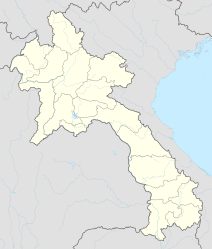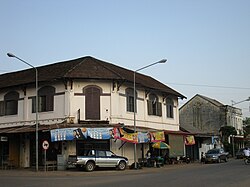Thakhek
|
ທ່າ ແຂກ Thakhek |
||
|---|---|---|
|
|
||
| Coordinates | 17 ° 24 ' N , 104 ° 48' E | |
| Basic data | ||
| Country | Laos | |
| Khammuan | ||
| ISO 3166-2 | LA-KH | |
| Residents | 70,000 (?) | |
|
French colonial houses
|
||
Thakhek ( Lao : ທ່າ ແຂກ , ALA-LC : Thā Khǣk , pronunciation: [tʰāː kʰɛ̂ːk] ) is a city in central Laos with about 70,000 inhabitants.
It is the administrative capital of Khammuan Province . It is located on the banks of the Mekong , across from the Thai city of Nakhon Phanom , with which it has been linked by the Third Thai-Lao Friendship Bridge since 2011 . After Vientiane is 335 kilometers. Before the country's independence, it was a French administrative center, which can still be seen in the old town. Some villas and several commercial buildings in the unmistakably French colonial style are still preserved here today. The Catholic Church not far east of the city center was also built by the French.
Thakhek was the end of the Tân Ằp – Thakhet railway, which began in 1929 but was never completed .
Attractions
Thakhek is an interesting starting point for excursions into the karst landscapes of the Khammuan province. Among other things, the rock formation "Kampaeng Yak", which is up to 30 meters high and only up to one meter wide, is worth seeing. It looks like a huge wall made of large blocks and extends over several kilometers. There are various legends about its origin. One of them says that the wall of giants - called "Khon Paet Soek", which literally means "eight cubits people" - is said to have been built. These giants are said to have made the huge stone vessels on the level of the clay jugs . A well-preserved section of the wall can be seen in the village of Ban Na Gna Vai, six kilometers north of Thakhek, on National Road 13 .
There are also several caves in the vicinity of Thakhek. One of the most famous is the Tham Pa Fa cave, 18 kilometers east of the city, in which there are 229 Buddha statues - partly made of bronze, partly made of pure gold - of different sizes. The cave was only discovered in 2004 and is now an important place of pilgrimage.
Six kilometers south of the city rises the almost 30 meter high stupa That Sikhottabong on the Mekong , one of the most important pilgrimage sites in Laos. It is probably as old as the architecturally similar That Phanom on the opposite side of the Mekong, so its history goes back at least to the 10th century, when the Indianized kingdom of Sikhottabong ( Sanskrit Śri Gotapura ) existed here. It was renovated, expanded and redesigned in the 16th century during the reign of Setthathirats and in the 19th century under King Anouvong . Its gold-plated tip, based on the shape of a closed banana blossom, is visible from afar. Every year in February a 3-day festival is celebrated here, which attracts pilgrims from all over the country. It is also an important pilgrimage destination on Khao Phansa (usually in July).
history
Around the 13th century, the presumably multiethnic Śri Gotapura, influenced by Dvaravati , came under the rule of the Lao , who called it Müang Kabong or Sikhottabong. It was initially an important, autonomous principality before Fa Ngum incorporated it into his kingdom of Lan Xang after 1350 and committed the local rulers to fealty . But it remained one of the most important cities of Lan Xang even after that, in the 15th and 16th centuries.
In the 17th century, Sikhottabong lost its importance, while Lakhon / Nakhon Phanom, founded on the opposite side of the Mekong, took over its role as a provincial center.
The modern Thakhek was built as an administrative center during the French colonial era. It was mostly inhabited by Vietnamese, Lao made up only 15% of the population around 1940. During the Lao Civil War , Thakhek was captured by Pathet Lao and Việt Minh in 1953 . Subsequently, the Vietnamese population declined and Thakhek became a predominantly Laotian city. The population was only 20,000 at the beginning of the 1990s, by 2005 it had already more than doubled. With the completion of the Third Thai-Laotian Friendship Bridge in 2011 as part of the Greater Mekong Subregion development project coordinated by the Asian Development Bank , it has since grown in importance.
Web links
Individual evidence
- ↑ Martin H. Petrich: Vietnam, Cambodia and Laos. Temples, monasteries and pagodas in the countries on the Mekong. DuMont, Cologne 2004, pp. 429-430.
- ^ Marc Askew: Urbanism and the Lao world of the Mekong Valley. In: Vientiane. Transformations of a Lao Landscape. Routledge, Abingdon (Oxon) / New York 2007, pp. 16–42, on p. 29.
- ↑ Askew: Urbanism and the Lao world of the Mekong Valley. 2007, p. 30.
- ↑ Askew: Urbanism and the Lao world of the Mekong Valley. 2007, p. 33.
- ↑ Askew: Urbanism and the Lao world of the Mekong Valley. 2007, p. 37.
- ↑ Askew: Urbanism and the Lao world of the Mekong Valley. 2007, p. 32.
- ^ A b Martin Stuart-Fox : Historical Dictionary of Laos. 3rd edition, Scarecrow Press, Lanham MD / Plymouth 2008, p. 341, entry Thakhek .
- ^ Colin Long, Marc Askew: Arena of the Cold War. In: Vientiane. Transformations of a Lao Landscape. 2007, pp. 111-150, at p. 116.





